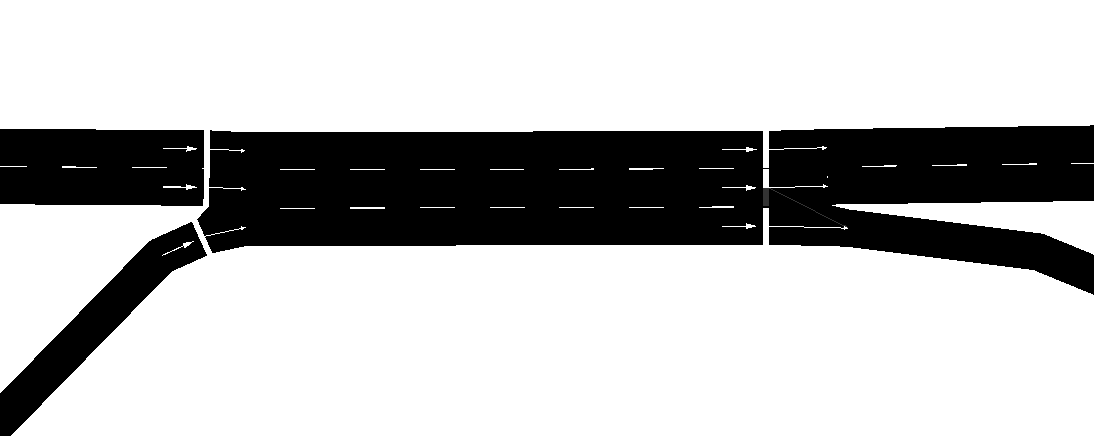Motorway Simulation#
This page describes simulations of motorways in SUMO. It aims to collect best practices when modelling motorway networks and traffic.
Building a network for motorway simulation#
Networks can be imported from any supported data source or created from scratch with netedit. Depending on the level of detail special processing may be necessary
Motorway ramps#
If the network does not contain detailed ramp data, netconvert can be configured to add them heuristically. This basically adds acceleration lanes at on-ramps and deceleration lanes at off-ramps by increasing the lane count of one or more edges.
Ramps usually merge into the main road via an acceleration lane. This acceleration lane opens up where the ramp enters the motorway and is modelled as a dead-end lane (no outgoing connection). This forces on-ramp vehicles to change lanes in order to continue their route.
It may be useful to make acceleration lanes in SUMO somewhat longer than in reality. This compensates for the cautious default behavior of SUMO drivers: Vehicles on the acceleration lane will decelerate when approaching the end of that lane since they cannot anticipate with certainty whether their lanechange will be successful. In contrast, human drivers are better at predicting the future and may accelerate up to the end of the acceleration lane (and then change into the anticipated gap at the last moment)
Reduction in the number of lanes#
The usual way to set up a lane-number reduction is to configure one of the lanes as a dead-end (no connection to the next edge) and force vehicles to change-lanes. In some situations it may be appropriate to declare the node where the lane number changes as a zipper node instead.
Combined On-Off-Ramps#
Combined ramps are those where the acceleration lane from an on-ramp becomes the deceleration lane for a nearby off-ramp. This forces vehicles into a weaving pattern where entering and exiting vehicles need to swap lanes. This type of situation may cause deadlocks in sumo unless preventive measures are taking. The problem is exacerbated if the acceleration/deceleration lane is short or traffic is very dense.
To prevent deadlocks the connection pattern shown in the following image should be used. Note, that the off-ramp is targeted by the two rightmost lanes of the preceding edge and lane 0 has priority over lane 1. Vehicles exiting the motorway will attempt to move to the rightmost lane if possible but can still continue their route if that lane is occupied.
 Connectivity at on-off-ramp
Connectivity at on-off-ramp
You can can create this kind of connectivity in netedit connection mode with Ctrl + click.
Note
A similar problem can be found in some types of multi-lane roundabouts. The same solution is applicable.
Vehicle class specific speed limits#
In some jurisdictions, certain vehicle classes have specific speed limits (i.e. Trucks which may not drive faster than 90km/h on German motorways). This should be modelled as described here: Networks/PlainXML#vehicle-class_specific_speed_limits
Lane-changing prohibitions#
Lane-changing prohibitions can be modelled using the lane attributes 'changeLeft' and 'changeRight' with a list of vehicle classes that may change. To disable changing right for normal passenger traffic, set 'changeRight="authority"`.
Defining Motorway Traffic#
Speed Distributions#
To achieve a realistic scenario, the desired vehicle speeds should be heterogeneous. This can be achieved by setting the vType-attributes speedFactor and speedDev. Since a vehicle speedFactor defines desired speed relative to the speed limit of each edge, #Vehicle_class_specific_speed_limits should be taken into account.
High Flows#
Some tips on how to achieve high flows are described in the FAQ
